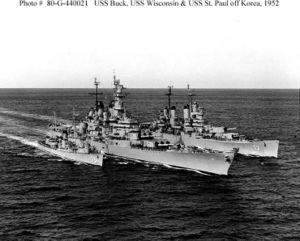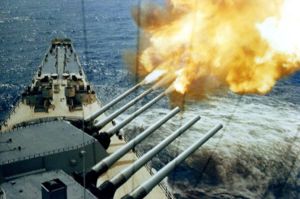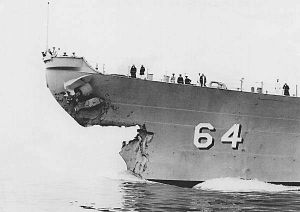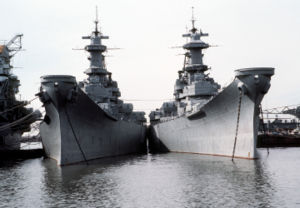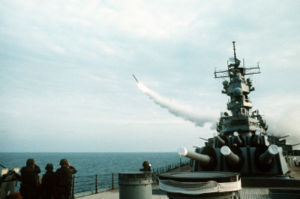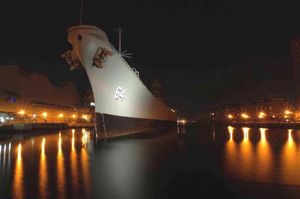USS Wisconsin (BB-64)
2007 Schools Wikipedia Selection. Related subjects: Military History and War
USS Wisconsin (BB-64) is an Iowa-class battleship, and is the second ship of the United States Navy named in honour of the U.S. state of Wisconsin. She was built at the Philadelphia Navy Yard, and launched on December 7, 1943.
During her career Wisconsin served in World War II, where she shelled Japanese fortifications at Leyte Gulf, and screened US aircraft carriers as they conducted air raids against enemy positions. During the Korean War she shelled North Korean targets in support of UN and South Korean ground operations, after which she was decommissioned into the United States Navy reserve fleets, better known as the mothball fleet. She was reactivated and modernized in 1986 as part of the " 600-ship Navy" plan, and participated in the 1991 Gulf War.
Wisconsin was last decommissioned in September 1991, having earned a total of six battle stars for war service in WWII and Korea, and a Navy Unit Commendation for service during the 1991 Gulf War, and currently functions as a museum ship at Nauticus, The National Maritime Centre in Norfolk, Virginia. Wisconsin was struck from the Naval Vessel Register (NVR) 17 March 2006, and is currently awaiting donation for permanent use as a museum ship.
Construction
Wisconsin was one of the "fast battleship" designs planned in 1938 by the Preliminary Design Branch at the Bureau of Construction and Repair. She was the third of the four completed ships of the Iowa class of battleships. Although Wisconsin is numerically the highest numbered US battleship built, she was actually completed before USS Missouri, making Missouri the last completed US battleship. Her keel was laid down on January 25, 1941, at the Philadelphia Navy Yard. She was launched on December 7, 1943, sponsored by Mrs. Walter S. Goodland, and commissioned on April 16, 1944, with Captain Earl E. Stone in command.
World War II (1944-1945)
Shakedown and service with 3rd Fleet, Admiral Halsey
After the ship's trials and initial training in the Chesapeake Bay, Wisconsin departed Norfolk, Virginia, on July 7, 1944, bound for the British West Indies. Following her shakedown (conducted out of Trinidad) she returned to the builder's yard for alterations and repairs.
On 24 September 1944, Wisconsin sailed for the west coast, transited the Panama Canal, and reported for duty with the Pacific Fleet on 2 October. The battleship later moved to Hawaiian waters for training exercises and then headed for the Western Caroline Islands. Upon reaching Ulithi on 9 December, she joined Admiral William F. Halsey's Third Fleet.
Wisconsin had arrived at a time when the reconquest of the Philippines was well underway. As a part of that movement, the planners had envisioned landings on the southwest coast of Mindoro, south of Luzon. From that point, American forces could threaten Japanese shipping lanes through the South China Sea. In preparation for the coming invasion of Mindoro, Wisconsin was assigned to protect the Third Fleet's Fast Carrier Task Force (TF) 38, as they conducted air raids at Manila to soften up Japanese positions.
The next day the weather, however, soon turned sour for Halsey's sailors. A furious typhoon struck his fleet, catching many ships refueling and with little ballast in their nearly dry bunkers. Three destroyers, Hull (DD-350), Monaghan (DD-354), and Spence (DD-512), capsized and sank. Wisconsin proved her seaworthiness as she escaped the storm unscathed.
Wisconsin’s next operation was in the Philippines, specifically the occupation of Luzon. Bypassing the southern beaches, American amphibians went ashore at Lingayen Gulf, the scene of the Japanese landings nearly three years before.
Wisconsin, armed with heavy anti-aircraft batteries, performed escort duty for TF 38's fast carriers during air strikes against Formosa, Luzon, and the Nansei Shoto, to neutralize Japanese forces there and to cover the unfolding Lingayen Gulf operations. Those strikes, lasting from 3 January to 22 January 1945, included a thrust into the South China Sea, in the hope that major units of the Imperial Japanese Navy could be drawn into battle.
Wisconsin’s carrier group launched air strikes between Saigon and Camranh Bay, Indochina, on 12 January resulted in severe losses for the enemy. TF 38's warplanes sank 41 ships and heavily damaged docks, storage areas, and aircraft facilities. Formosa, already struck on 3 January and 4 January, was raided again on 9 January, 15 January, and 21 January. Throughout January Wisconsin shielded the carriers as they conducted air raids at Hong Kong, Canton, Hainan Island, the Canton oil refineries, the Hong Kong Naval Station, and Okinawa.
Service with 5th Fleet, Admiral Spruance
Wisconsin was assigned to the Fifth Fleet when Admiral Raymond A. Spruance relieved Admiral Halsey as Commander of the Fleet. She moved northward with the redesignated TF 58 as the carriers headed for the Tokyo area. On 16 February 1945, the task force approached the Japanese coast under cover of adverse weather conditions and achieved complete tactical surprise. As a result, Wisconsin and the other ships shot down 322 enemy planes and destroyed 177 more on the ground. Japanese shipping, both naval and merchant, suffered drastically, too, as did hangars and aircraft installations.
Wisconsin and the task force moved to Iwo Jima on 17 February to provide direct support for the landings slated to take place on that island on 19 February. They revisited Tokyo on 25 February and, the next day, hit the island of Hachino off the coast of Honshu- which resulted in heavy damage to ground facilities; additionally, the American planes sank five small vessels and destroyed 158 planes.
Wisconsin's task force stood out of Ulithi on 14 March, bound for Japan. The mission of that group was to eliminate airborne resistance from the Japanese homeland to American forces off Okinawa. Enemy fleet units at Kure and Kobe, on southern Honshu-, reeled under the impact of the explosive blows delivered by TF 58's airmen. On 18 March and 19 March, from a point 100 miles (160 km) southwest of Kyu-shu-, TF 58 hit enemy airfields on that island; unfortunately, allied anti-aircraft fire on 19 March failed to stop a Kamikaze attack on the carrier Franklin (CV-13). That afternoon, Wisconsin and the task force retired from Kyu-shu-, screening the blazing and battered flattop, and in doing so, the screen shot down 48 attackers.
On 24 March, Wisconsin trained her 16 inch (406 mm) guns on targets ashore on Okinawa. Together with the other battlewagons of the task force, she pounded Japanese positions and installations in preparation for the landings. Japanese resistance, while fierce, was doomed to failure by dwindling numbers of aircraft and trained pilots.
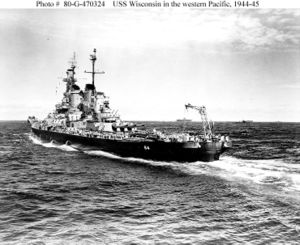
While TF 58's planes were dealing with Yamato and her escorts, enemy aircraft attacked the American surface units. Combat air patrols (CAP) shot down 15 enemy planes, and ships' gunfire shot down another three, but not before one Kamikaze attack penetrated the CAP and screen to crash on the flight deck of the fleet carrier Hancock (CV-19). On 11 April, the Japanese renewed their Kamikaze attacks; and only drastic maneuvers and heavy barrages of gunfire saved the task force. Combat air patrols shot down 17 planes, and ships' gunfire shot down 12. The next day, 151 enemy aircraft attacked TF 58, but Wisconsin, together with other units of the screens for the vital carriers, kept the Kamikaze pilots at bay and destroyed them before they could reach their targets. Over the days that ensued Japanese suicide attacks managed to crash into three carriers — Intrepid (CV-11), Bunker Hill (CV-17) and Enterprise (CV-6) — on successive days.
By 4 June, a typhoon was swirling through the Fleet. Wisconsin rode out the storm unscathed, but three cruisers, two carriers, and a destroyer suffered serious damage. Offensive operations were resumed on 8 June with a final aerial assault on Kyu-shu-. Japanese aerial response was virtually nonexistent; 29 planes were located and destroyed. On that day, one of Wisconsin’s floatplanes landed and rescued a downed pilot from the carrier Shangri-La (CV-38).
Bombardment of Japan
Wisconsin ultimately put into Leyte Gulf and dropped anchor there on 18 June for repairs and replenishment. Three weeks later, on 1 July, the battleship and her escorts sailed once more for Japanese home waters for carrier air strikes on the enemy's heartland. Nine days later, carrier planes from TF 38 destroyed 72 enemy aircraft on the ground and smashed industrial sites in the Tokyo area. Wisconsin and the other ships made no attempt whatsoever to conceal the location of their armada, due in large part to a weak Japanese response to their presence.
On 16 July, Wisconsin fired the 16 inch (406 mm) guns at the steel mills and oil refineries at Muroran, Hokkaido. Two days later, she wrecked industrial facilities in the Hitachi Miro area, on the coast of Honshu, northeast of Tokyo itself. During that bombardment, British battleships of the British Pacific Fleet contributed their heavy shellfire. By that point in the war, Allied warships such as Wisconsin were able to shell the Japanese homeland almost at will.
Task Force 38's planes subsequently blasted the Japanese naval base at Yokosuka, and put the former fleet flagship Nagato out of action, one of the two remaining Japanese battleships. Throughout July and into August Admiral Halsey's airmen visited destruction upon the Japanese, the last instance being against Tokyo on 13 August 1945. Two days later, the Japanese surrendered. World War II was over at last.
Wisconsin, as part of the occupying force, arrived at Tokyo Bay on 5 September, three days after the formal surrender occurred on board the battleship Missouri (BB-63). During Wisconsin’s brief career in World War II, she had steamed 105,831 miles (170,318 km) since commissioning; had shot down three enemy planes; had claimed assists on four occasions; and had fueled her screening destroyers on some 250 occasions.
Post WWII (1945-1950)
Shifting subsequently to Okinawa, the battleship embarked homeward-bound GIs on 22 September, as part of Operation Magic Carpet staged to bring soldiers, sailors, and marines home from the far-flung battlefronts of the Pacific. Departing Okinawa on 23 September, Wisconsin reached Pearl Harbour on 4 October, remaining there for five days before she pushed on for the west coast on the last leg of her state-side bound voyage. She reached San Francisco, California, on 15 October.
Heading for the east coast of the United States soon after the start of the new year, 1946, Wisconsin transited the Panama Canal between 11 January and 13 January and reached Hampton Roads, Virginia, on 18 January. Following a cruise south to Guantánamo Bay, Cuba, the battleship entered the Norfolk Naval Shipyard for overhaul. After repairs and alterations that consumed the summer months, Wisconsin sailed for South American waters.
Over the weeks that ensued, the battleship visited Valparaíso, Chile, from 1 November to 6 November; Callao, Peru, from 9 November to 13 November; Balboa, Canal Zone, from 16 November to 20 November; and La Guaira, Venezuela, from 22 November to 26 November, before returning to Norfolk on 2 December 1946.
Wisconsin spent nearly all of 1947 as a training ship, taking naval reservists on two-week cruises throughout the year. Those voyages commenced at Bayonne, New Jersey, and saw visits conducted at Guantánamo Bay, Cuba, and the Panama Canal Zone. While underway at sea, the ship would perform various drills and exercises before the cruise would end where it had started, at Bayonne. During June and July of 1947, Wisconsin took United States Naval Academy midshipmen on cruises to northern European waters.
In January 1948, Wisconsin reported to the Atlantic Reserve Fleet at Norfolk, for inactivation. Placed out of commission, in reserve on 1 July 1948 Wisconsin was assigned to the Norfolk group of the Atlantic Reserve Fleet.
The Korean War (1950-1952)
Her sojourn in "mothballs," however, was comparatively brief, due to the North Korean invasion of South Korea in late June 1950. Wisconsin was recommissioned on 3 March 1951 with Captain Thomas Burrowes in command. After shakedown training, the revitalized battleship conducted two midshipmen training cruises, taking the officers-to-be to Edinburgh, Scotland; Lisbon, Portugal; Halifax, Nova Scotia; New York City; and Guantánamo Bay, Cuba, before she returned to Norfolk. While leaving New York Wisconsin was accidentally grounded on mud flats in New York Harbour, but was freed on 23 August 1951 with no damage to the ship.
Wisconsin departed Norfolk on 25 October 1951, bound for the Pacific. She transited the Panama Canal on 29 October and reached Yokosuka, Japan, on 21 November. There, she relieved New Jersey (BB-62) as flagship for Vice Admiral H. M. Martin, Commander, Seventh Fleet.
On 26 November, with Vice Admiral Martin and Rear Admiral F.P. Denebrink, Commander, Service Force, Pacific, embarked, Wisconsin departed Yokosuka for Korean waters to support the fast carrier operations of TF 77. She left the company of the carrier force on 2 December and, screened by the destroyer Wiltsie (DD-716), provided gunfire support for the Republic of Korea (ROK) Corps in the Kasong- Kosong area. After disembarking Admiral Denebrink on 3 December at Kangnung, the battleship resumed station on the Korean "bombline," providing gunfire support for the American 1st Marine Division. Wisconsin’s shellings accounted for a tank, two gun emplacements, and a building. She continued her gunfire support task for the 1st Marine Division and 1st ROK Corps through 6 December, accounting for enemy bunkers, artillery positions, and troop concentrations. On one occasion during that time, the battleship received a request for call-fire support and provided three star-shells for the 1st ROK Corps, illuminating an enemy attack that was consequently repulsed with considerable enemy casualties.
After being relieved on the gunline by the heavy cruiser St. Paul (CA-73) on 6 December, Wisconsin retired only briefly from gunfire support duties. She resumed them, however, in the Kasong-Kosong area on 11 December screened by the destroyer Twining (DD-540). The following day, 12 December, saw the embarkation in Wisconsin of Rear Admiral H. R. Thurber, Commander, Battleship Division 2. The admiral came on board via helicopter, incident to his inspection trip in the Far East.
The battleship continued naval gunfire support duties on the "bombline," shelling enemy bunkers, command posts, artillery positions, and trench systems through 14 December. She departed the "bombline" on that day to render special gunfire support duties in the Kojo area blasting coastal targets in support of United Nations (UN) troops ashore. That same day, she returned to the Kasong-Kosong area. On 15 December, she disembarked Admiral Thurber by helicopter. The next day, Wisconsin departed Korean waters, heading for the Sasebo U.S. Fleet Activities base to rearm.
Returning to the combat zone on 17 December, Wisconsin embarked United States Senator Homer Ferguson of Michigan on 18 December. That day, the battleship supported the 11th ROK invasion with night illumination fire that enabled the ROK troops to repulse a North Korean assault with heavy enemy casualties. Departing the "bombline" on 19 December, the battleship later that day transferred her distinguished passenger, Senator Ferguson, by helicopter to the carrier Valley Forge (CV-45).
On 20 December Wisconsin participated in a coordinated air-surface bombardment of Wonsan to neutralize pre-selected targets in the Wonson area. She shifted her bombardment station to the western end of Wonsan harbour, hitting boats and small craft in the inner swept channel with her 5-in guns during the afternoon. Such activities helped to forestall any attempts to assault the friendly-held islands in the Wonsan area. Wisconsin then made an anti-boat sweep to the north, firing her five inch (127 mm) batteries on suspected boat concentrations. She then provided gunfire support to UN troops operating at the "bombline" until 22 December 1951, when she rejoined the carrier task force.
On 28 December, Francis Cardinal Spellman, on a Korean tour over the Christmas holidays, visited the ship, coming on board by helicopter to celebrate Mass for the Catholic members of the crew. He left the ship by helicopter off Pohang. Three days later, on the last day of the year, Wisconsin put into Yokosuka.
Wisconsin departed that Japanese port on 8 January 1952 and headed for Korean waters once more. She reached Pusan the following day and entertained the President of South Korea, Syngman Rhee, and his wife, on 10 January. President and Mrs. Rhee received full military honours as they came on board, and he reciprocated by awarding Vice Admiral Martin the ROK Order of the Military Merit.
Wisconsin returned to the "bombline" on 11 January, and over the ensuing days delivered heavy gunfire support for the 1st Marine Division and the 1st ROK Corps. As before, her primary targets were command posts, shelters, bunkers, troop concentrations and mortar positions. As before, she stood ready to deliver call-fire support as needed. One such occasion occurred; on 14 January when she shelled enemy troops in the open at the request of the ROK 1st Corps.
Rearming at Sasebo and once more joining TF 77 off the coast of Korea soon thereafter, Wisconsin resumed support at the "bombline" on 23 January. Three days later, she shifted once more to the Kojo region, to participate in a coordinated air and gun strike. That same day, the battleship returned to the "bombline" and shelled the command post and communications centre for the 15th North Korean Division during call-fire missions for the 1st Marine Division.
Returning to Wonsan at the end of January, Wisconsin bombarded enemy guns at Hodo Pando before she was rearmed at Sasebo. The battleship rejoined TF 77 on 2 February and the next day, blasted railway buildings and marshaling yards at Hodo Pando and Kojo before rejoining TF 77. After replenishment at Yokosuka a few days later, she returned to the Kosong area and resumed gunfire support. During that time, she destroyed railway bridges and a small shipyard besides conducting call-fire missions on enemy command posts, bunkers, and personnel shelters, making numerous cuts on enemy trench lines in the process.
On 26 February, Wisconsin arrived at Pusan where Vice Admiral Shon, the ROK Chief of Naval Operations; United States Ambassador J.J. Muccio; and Rear Admiral Scott-Montcrief, Royal Navy, Commander, Task Group 95.12, visited the battleship. Departing that South Korean port the following day, Wisconsin reached Yokosuka on 2 March, and a week later she shifted to Sasebo to prepare to return to Korean waters.
Wisconsin arrived off Songjin, Korea, on 15 March 1952 and concentrated her gunfire on enemy railway transport. Early that morning, she destroyed a communist troop train trapped outside of a destroyed tunnel. That afternoon, she received the first direct hit in her history, when one of four shells from a communist 155 mm (aproximately 6 in) gun battery struck the shield of a starboard 40 mm mount. Although little material damage resulted, three men were injured. Wisconsin subsequently destroyed that battery with a 16 inch (406 mm) salvo before continuing her mission. After lending a hand to support once more the 1st Marine Division with her heavy rifles, the battleship returned to Japan on 19 March.
Relieved as flagship of the Seventh Fleet on 1 April by sister ship Iowa (BB-61), Wisconsin departed Yokosuka, bound for the United States. En route home, she touched briefly at Guam, where she took part in the successful test of the Navy's largest floating dry-dock on 4 April and 5 April, marking the first time that an Iowa-class battleship had ever utilized that type of facility. She continued her homeward-bound voyage, via Pearl Harbour, and arrived at Long Beach, California on 19 April; she then sailed for Norfolk.
Post Korean War (1952-1981)
On 9 June 1952 Wisconsin resumed her role as a training ship, taking midshipmen to Greenock, Scotland; Brest, France; and Guantánamo Bay, Cuba, before returning to Norfolk. She departed Hampton Roads on 25 August and participated in the NATO exercise Operation Mainbrace, which was held out of Greenock, Scotland. After her return to Norfolk, Wisconsin underwent an overhaul in the naval shipyard there. Wisconsin remained in the Atlantic fleet throughout 1952 and into 1953, training midshipmen and conducting exercises. After a month of routine maintenance Wisconsin departed Norfolk on 9 September 1953, bound for the Far East.
Sailing via the Panama Canal to Japan, Wisconsin relieved New Jersey (BB-62) as Seventh Fleet flagship on 12 October. During the months that followed, Wisconsin visited the Japanese ports of Kobe, Sasebo Navy Yard, Yokosuka, Otaru, and Nagasaki. She spent Christmas at Hong Kong and was ultimately relieved of flagship duties on 1 April 1954 and returned to the United States soon thereafter, reaching Norfolk, via Long Beach and the Panama Canal, on 4 May 1954.
Entering the Norfolk Naval Shipyard on 11 June, Wisconsin underwent a brief overhaul and commenced a midshipman training cruise on 12 July. After revisiting Greenock, Brest, and Guantánamo Bay, the ship returned to the Norfolk Naval Shipyard for repairs. Shortly thereafter, Wisconsin participated in Atlantic Fleet exercises as flagship for Commander, Second Fleet. Departing Norfolk in January 1955, Wisconsin took part in Operation Springboard, during which time she visited Port-au-Prince, Haiti. Then, upon returning to Norfolk, the battleship conducted another midshipman's cruise that summer, visiting Edinburgh; Copenhagen, Denmark; and Guantánamo Bay before returning to the United States.
Upon completion of a major overhaul at the New York Naval Shipyard, Wisconsin headed south for refresher training in the Caribbean Sea, later taking part in another Springboard exercise. During that cruise, she again visited Port-au-Prince and added Tampico, Mexico, and Cartagena, Colombia, to her list of ports of call. She returned to Norfolk on the last day of March 1956 for local operations. On 19 October 1955, while operating in the East River in the New York Harbour Wisconsin was accidentally grounded. Fortunately, the ship was freed in about an hour without any serious damage.
Throughout April and into May, Wisconsin operated locally off the Virginia capes. On 6 May, the battleship collided with the destroyer Eaton (DDE-510) in a heavy fog; Wisconsin put into Norfolk with extensive damage to her bow and, one week later, entered dry dock at the Norfolk Naval Shipyard. A novel expedient speeded her repairs and enabled the ship to carry out her scheduled midshipman training cruise that summer. A 120 ton, 68 foot (21 m) section of the bow of the uncompleted battleship Kentucky was transported by barge, in one section, from Newport News Shipbuilding and Drydock Corporation of Newport News, Virginia, across Hampton Roads to the Norfolk Naval Shipyard. Working round-the clock, Wisconsin’s ship's force and shipyard personnel completed the operation which grafted the new bow on the old battleship in a mere 16 days. On 28 June 1956, the ship was ready for sea.
Wisconsin resumed her midshipman training on 9 July 1956. That autumn, Wisconsin participated in Atlantic Fleet exercises off the coast of the Carolinas, returning to port on 8 November 1956. Entering the Norfolk Naval Shipyard a week later, the battleship underwent major repairs that were not finished until 2 January 1957.
After local operations off the Virginia capes from 3 January 1957 to 4 January 1957 and from 9 January to 11 January, Wisconsin departed Norfolk on 16 January, reporting to Commander, Fleet Training Group, at Guantánamo Bay. Wisconsin served as Admiral Henry Crommelin's flagship during the ensuing shore bombardment practices and other exercises held off the isle of Culebra, Puerto Rico, from 2 February to 4 February 1957. Sailing for Norfolk upon completion of the training period, the battleship arrived on 7 February and resumed local operations off Norfolk. On 27 March Wisconsin sailed for the Mediterranean Sea, reaching Gibraltar on 6 April 1957, she pushed on that day to rendezvous with TF 60 in the Aegean Sea before reporting to Turkey for the NATO Exercise Red Pivot.
Departing Xeros Bay on 14 April, she arrived at Naples four days later, Wisconsin conducted exercises in the eastern Mediterranean. In the course of those operational training evolutions, she rescued a pilot and crewman who survived the crash of a plane from the carrier Forrestal (CVA-59). Wisconsin reached Valencia, Spain, on 10 May and, three days later, entertained prominent civilian and military officials of the city.
Departing Valencia on 17 April, Wisconsin reached Norfolk on 27 May. On that day, Rear Admiral L.S. Parks relieved Rear Admiral Crommelin as Commander, Battleship Division 2.< Departing Norfolk on 19 June, the battleship, over the ensuing weeks, conducted a midshipman training cruise through the Panama Canal to South American waters, and reached Valparaiso on 3 July. Eight days later, the battleship headed back to the Panama Canal and the Atlantic.
After exercises at Guantánamo Bay and off Culebra, Wisconsin reached Norfolk on 5 August and conducted local operations that lasted into September. She then participated in NATO exercises which took her across the North Atlantic to the British Isles.
Wisconsin’s days as an active fleet unit were numbered, and she prepared to make her last cruise. On 4 November 1957, she departed Norfolk with a large group of prominent guests on board. Reaching New York City on 6 November, the battleship disembarked her guests and, on 8 November, headed for Bayonne, New Jersey, to commence pre-inactivation overhaul. She was placed out of commission at Bayonne on 8 March 1958, and joined the "Mothball Fleet" there, leaving the United States Navy without an active battleship for the first time since 1896. Subsequently taken to the Philadelphia Naval Shipyard, Wisconsin remained there with her sister ship Iowa into the 1980s.
Reactivation (1986-1990)
As part of President Ronald Reagan's Navy Secretary John F. Lehman's effort to create a " 600-ship Navy" Wisconsin was reactivated 1 August 1986 and moved under tow to the Avondale Shipyard in New Orleans, Louisiana, to commence pre-re-commissioning workups. The battleship was then towed from the Avondale Shipyard and arrived at Ingalls Shipbuilding 2 January 1986 to recieve weapons system upgrades for her modernization. During the modernization Wisconsin had all of her remaining Oerlikon 20 mm and Bofors 40 mm anti-aircraft guns removed, due to their ineffectiveness against modern day jet fighters and enemy anti-ship missiles; additionally, the two 5" gun mounts located in the aft on the port and starboard side of the battleship were removed.
Over the next several months the ship was upgraded with the most advanced weaponry available; among the new weapons systems installed were four MK 141 quad cell launchers for 16 AGM-84 Harpoon anti-ship missiles, eight Armored Box Launcher (ABL) mounts for 32 BGM-109 Tomahawk missiles, and a quartet of the United States Navy's Phalanx Close In Weapon System (CIWS) gatling guns for defense against enemy anti-ship missiles and enemy aircraft. Wisconsin also received eight RQ-2 Pioneer Unmanned Aerial Vehicles, which are remotely controlled drones that replaced the helicopters previously used to spot for her nine 16"/50 Mark 7 guns. Also included in her modernization were upgrades to radar and fire control systems for her guns and missiles, and improved electronic warfare capabilities. Armed as such, Wisconsin was formally recommissioned on 22 October 1988 in Pascagoula, Mississippi and assigned to the United States Atlantic fleet.
Wisconsin spent the first part of 1989 conducting training exercises in the Atlantic Ocean and off the coast of Puerto Rico before returning to the Philadelphia Naval Shipyard for a post recommissioning shakedown that lasted the rest of the year. In mid-1990 the battleship participated in a fleet exercise.
Gulf War (1990-1991)
On 2 August 1990 Saddam Hussein's Iraq invaded Kuwait. In the middle of the month, President George H. W. Bush, in keeping with the Carter Doctrine, sent the first of several hundred thousand troops, along with a strong force of naval support to Saudi Arabia and the Persian Gulf area to support a multi-national force in a standoff with the Iraqi dictator. On 7 August 1990 Wisconsin was ordered to deploy in defense of Kuwait for Operation Desert Shield, and arrived in the Persian Gulf 23 August. When Operation Desert Shield became Operation Desert Storm, Wisconsin found herself serving alongside her younger sister Missouri, just as she had done in Korea forty years previously. Both Wisconsin and Missouri launched missile attacks against Iraq; they were among the first ships to fire off missiles during the 1991 Gulf War. Wisconsin served as the TLAM strike commander for the Persian Gulf, directing the sequence of launches that marked the opening of Operation Desert Storm and firing a total of 24 of her own TLAMs during the first two days of the campaign.
Wisconsin, escorted by Nicholas, relieved Missouri on 6 February, then answered her first combat call for gunfire support since March 1952. The most recently recommissioned battleship sent 11 shells across 19 miles of space to destroy an Iraqi artillery battery in southern Kuwait. Using an Unmanned Aerial Vehicle (UAV) as a spotter in combat for the first time, Wisconsin pounded Iraqi targets and Iraqi boats that had been used during raids along the Saudi Arabian coast. On 7 February Wisconsin fired her guns against Iraqi artillery sites, missile facilities, and electronic warfare sites along the coast. She also targeted naval sites with her 16 inch guns firing several rounds which severely damaged or sunk 15 Iraqi boats, and destroyed several piers at the Khawr al-Mufattah Marina. In response to calls for fire support from U.S. and coalition forces Wisconsin’s turrets boomed again on 9 February, blasting bunkers and artillery sites, and shelling Iraqi troop positions near Khafji after the Iraqis were ousted from the city by Saudi and Qatari armor. Wisconsin and Missouri alternated positions on the gun line, using their 16 inch guns to destroy enemy targets and soften defenses along the Kuwait coastline for a possible amphibious assault.
On the night of 23 February Missouri and Wisconsin turned their big guns on Faylaka Island to support the ground offensive in Iraq. The two ships were to conduct a diversionary assault aimed at convincing the Iraqi forces arrayed along the shores of Faylaka Island that Coalition forces were preparing to launch an amphibious invasion. As part of this attack Missouri and Wisconsin were directed to shell known Iraqi defensive positions on the island. Shortly after Missouri completed her shelling of Faylaka Island Wisconsin, while still over the horizon (and thus out of visual range of the Iraqi forces) launched her RQ-2 Pioneer Unmanned Aerial Vehicle to spot for her 16 inch guns. As Wisconsin’s drone approached Faylaka Island the pilot of the drone was instructed to fly the vehicle low over Iraqi positions so that the soldiers would know that they were once again being targeted by a battleship. Iraqi troops on the ground heard the Pioneer’s distinctive buzzing sound, and having witnessed the effects of Missouri’s artillery strike on their trenchline the Iraqi troops decided to signal their willingness to surrender by waving makeshift white flags, an action dutifully noted aboard Wisconsin. Amused at this sudden development the men assigned to the drone’s aircrew called Wisconsin’s commanding officer, Captain David S. Bill III, and asked, "Sir, they want to surrender, what should I do with them?" This surrender to Wisconsin’s Pioneer has since become one of the most remembered moments of the Gulf War; the incident was also the first-ever surrender of enemy troops to an unmanned aircraft controlled by a ship.
The next day Wisconsin answered two separate call fire support missions for coalition forces by suppressing Iraqi troops barricaded in a pair of bunkers. After witnessing the effects of Wisconsin’s strike against the Iraqi positions an elated Saudi marine commander commented over the radio, "I wish we had a battleship in our navy."
Both Wisconsin and Missouri passed the million-pound mark of ordnance delivered on Iraqi targets by the time President Bush ended hostilities on 28 February. With one last salvo from her big guns, Wisconsin fired the last naval gunfire support mission of the war. Wisconsin remained in the Persian Gulf after the cease-fire took effect, and returned home on 28 March 1991. During the 6 months Wisconsin spent in the Persian Gulf she had flown 348 UAV hours, recorded 661 safe helicopter landings, steamed 46,000 nautical miles, fired 528 16 inch rounds, 881 5 inch rounds, and 5,200 20 mm Phalanx CIWS rounds. This was the last time that United States battleships actively participated in a foreign war.
Museum ship (1992-present)
With the collapse of the Soviet Union in the early 1990s and the absence of a perceived threat to the United States came drastic cuts in the defense budget, and the high cost of maintaining and operating battleships as part of the United States Navy's active fleet became uneconomical; as a result, Wisconsin was decommissioned on 30 September 1991 and was stricken from the Naval Vessel Register on 12 January 1995. On 15 October 1996 she was moved to the Norfolk Naval Shipyard, and on 12 February 1998 she was restored to the Naval Vessel Register. On 7 December 2000 the battleship was towed from Norfolk and berthed adjacent to Nauticus, The National Maritime Centre in Norfolk. Her weather decks have since been opened to the public, but the ship is still owned by the Navy and is considered part of the mothball fleet.
Wisconsin was named as one of two US Navy battleships that were to be maintained in accordance with the National Defense Authorization Act of 1996 (the other was Iowa). Both battleships were maintained in the United States Navy reserve fleets for use as shore bombardment vessels since their 16 in (405 mm) guns are capable of firing 2,700 lb projectiles approximately 24 nautical miles inland; However, Wisconsin is now over 60 years old and would require extensive modernization to return to the fleet since most of her technology dates back to World War II, and the missile and electronic warfare equipment added to the battleship during her 1980s modernization are now considered obsolete. Furthermore, during the 1991 Gulf War she was said to be hindered by Iraqi naval mines, and reports on the internet suggest that the majority of the shore bombardments were successfully carried out by US Oliver Hazard Perry-class frigates and their 3 in (76 mm) guns. In addition, the cost of modernizing Iowa and Wisconsin is estimated to be somewhere around $500 million for reactivation and $1.5 billion for full a modernization program.
On 17 March 2006 the Secretary of the Navy exercised his authority to strike Iowa and Wisconsin from the NVR, which has cleared the way for both ships to be donated for use as museums; however, Congress remains "deeply concerned" over the loss of naval surface gunfire support that the battleships provided, and has noted that "...navy efforts to improve upon, much less replace, this capability have been highly problematic." Partially as a consequence the US House of Representatives have asked that the battleships be kept in a state of readiness should they ever be needed again. Congress has asked that the following measures be implemented to ensure that, if need be, Wisconsin can be returned to active duty:
- Wisconsin must not be altered in any way that would impair her military utility;
- The battleship must be preserved in her present condition through the continued use of cathodic protection, dehumidification systems, and any other preservation methods as needed;
- Spare parts and unique equipment such as the 16 in gun barrels and projectiles be preserved in adequate numbers to support Wisconsin, if reactivated;
- The Navy must prepare plans for the rapid reactivation of Wisconsin should she be returned to the Navy in the event of a national emergency.
These four conditions closely mirror the original three conditions that the Nation Defense Authorization Act of 1996 laid out for the maintiance of Wisconsin while she was in the Mothball Fleet. It is unlikely that these conditions will impede the current plan to turn Wisconsin into a permanent museum ship at her berth in Norfolk.
Decorations
Wisconsin earned five battle stars for her World War II service and one for the Korean War. The ship also received the Navy Unit Commendation for service during the 1991 Gulf War.

